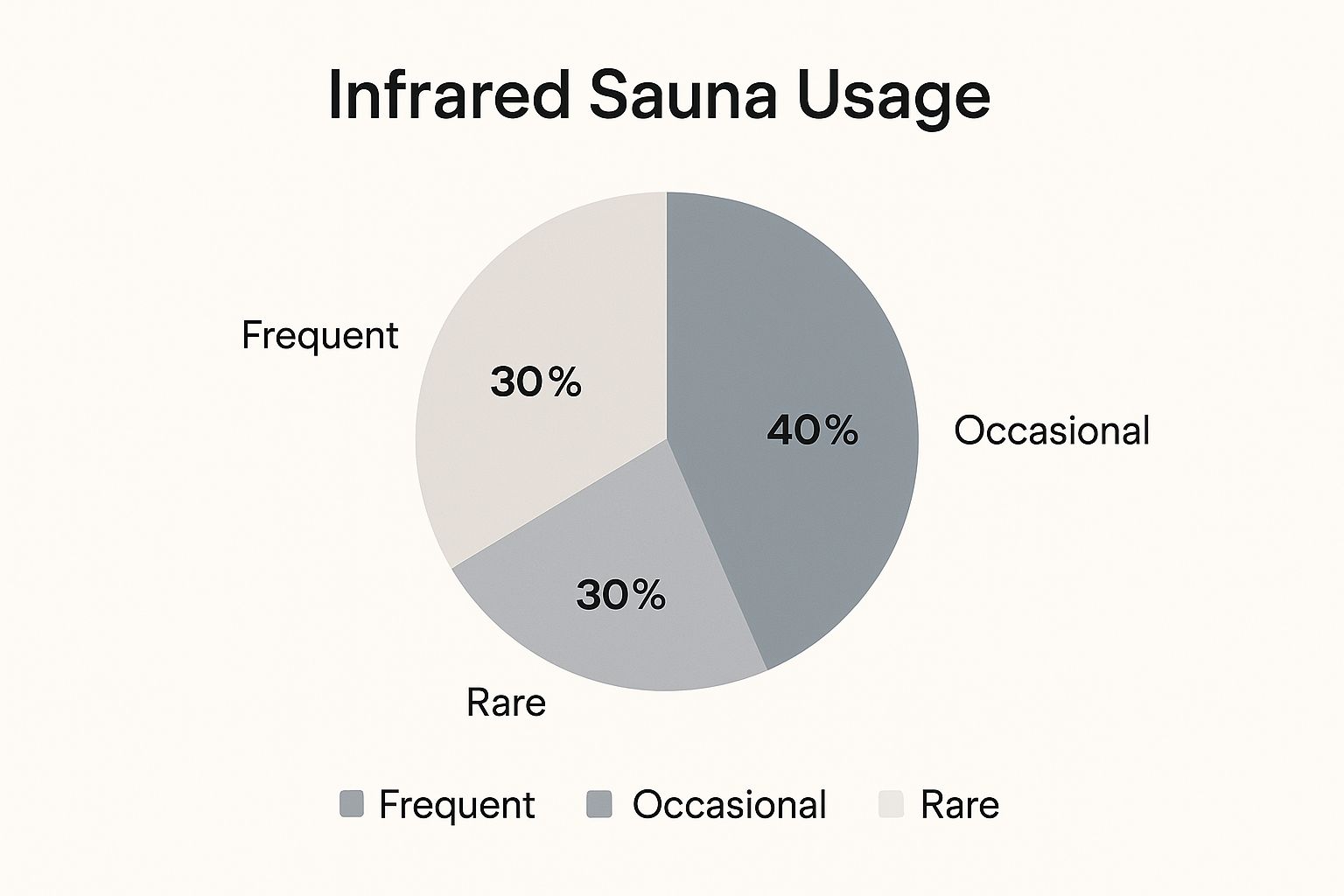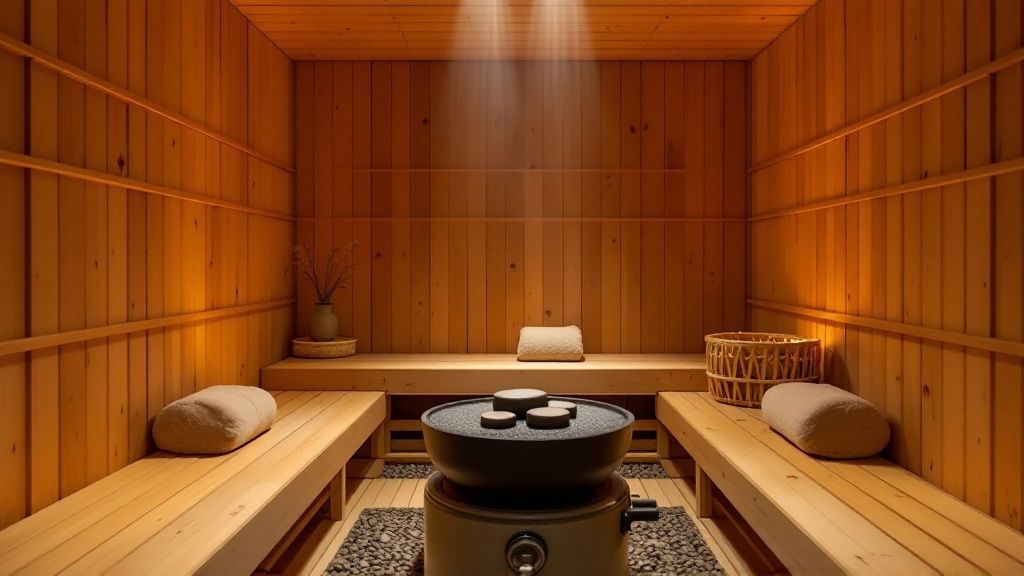
Infrared Sauna vs Dry Sauna A Definitive Comparison
When you get right down to it, the difference between an infrared sauna and a traditional dry sauna is pretty straightforward. Infrared saunas use radiant light to warm your body directly, while the classic dry sauna heats the air all around you with a powerful stove. The real question is, do you want a deep, penetrating warmth or an intense, all-encompassing heat?
Understanding the Core Differences
Choosing between an infrared and a traditional dry sauna isn’t about which one is flat-out better. It’s about finding the perfect match for your health goals, your lifestyle, and your home. The right sauna becomes a personal sanctuary for wellness, but the experience each one delivers is remarkably different. This guide is here to walk you through those differences so you can find your ideal fit.
At Mande Spa Outdoor, we specialize in top-tier saunas that ship directly from within the USA. This means you get to skip the long waits and questionable quality often found with lower-quality imports. Investing in your health should be a smooth process, and we stand by the superior craftsmanship we deliver. We encourage you to see the quality for yourself at the Mande Spa Outdoor link and find the perfect sauna to purchase.
This image shows a modern infrared sauna, showcasing the sleek design and direct heating panels that define the experience.

You can see the gentle, ambient glow that creates a comfortable environment, perfect for longer, more meditative relaxation sessions.
Heat Source and Temperature
The biggest difference comes down to how each sauna actually gets hot. A traditional dry sauna uses a gas, electric, or wood-burning heater to crank up the air temperature to a blistering 176°F to over 200°F. It's an intense, classic sweat session.
Infrared saunas, on the other hand, use light waves to heat your body from the inside out. This approach works beautifully at much lower and more tolerable temperatures, typically between 113°F and 140°F. You can learn more about different sauna heating methods and what makes them unique.
The core choice is between heating the room versus heating your body. A traditional sauna envelops you in hot air, while an infrared sauna targets you with deep, penetrating warmth.
To make things even clearer, here’s a quick summary of the most important distinctions.
At a Glance Infrared vs Dry Sauna Comparison
This table breaks down the key differentiators so you can see the two types of saunas side-by-side.
| Feature | Infrared Sauna | Traditional Dry Sauna |
|---|---|---|
| Heating Method | Radiant heat warms the body directly. | Convection heat warms the air first. |
| Operating Temp | Lower & gentler: 113°F - 140°F. | Hot & intense: 176°F - 200°F+. |
| Heat-Up Time | Fast, usually 10-20 minutes. | Slower, around 30-45+ minutes. |
| User Experience | A deep, soothing warmth for longer sessions. | An intense, enveloping "classic sauna" heat. |
Ultimately, both paths lead to a great sweat, but the journey to get there is what sets them apart. Your preference for a quick, gentle session versus a longer, more traditionally intense experience will be a major factor in your decision.
When you get right down to it, the whole infrared vs. dry sauna debate hinges on one thing: how they make you sweat. The heating technology is the secret sauce, and it creates two completely different experiences. Figuring out which one you’ll love is all about understanding this core difference.

A traditional dry sauna works through convection heating. It uses a stove—electric, gas, or even wood-fired—to superheat a pile of rocks. Those rocks then blast out heat, warming up the air in the cabin until it’s piping hot. This is an old-school, powerful warmth that hits you from the outside in.
The Traditional Dry Sauna Experience
The heart of the traditional sauna experience has a name: löyly. It’s a Finnish word for that satisfying hiss and burst of steam you get when you pour water over the hot stones. It spikes the humidity for a moment and makes the heat feel even more intense. It's a classic, robust feeling that sauna purists absolutely live for.
The best way to describe a traditional dry sauna is all-encompassing, intense heat. The air itself is thick with warmth, wrapping around you for a powerful and deeply traditional sweat.
This method isn’t instant. You have to give it time to heat up the entire space, which usually takes 30 minutes or more. For many people, though, that pre-sauna ritual is part of the charm.
The Modern Infrared Sauna Approach
Infrared saunas flip the script completely by using radiant heating. Instead of warming the air around you, specialized emitters send out infrared waves that penetrate your skin and warm your body directly. This approach gets your core temperature up from the inside out, triggering a deep sweat without the need for blistering hot air.
The efficiency here is a game-changer. Since it’s not trying to heat the whole cabin, an infrared sauna is ready to go in a fraction of the time—often just 10-15 minutes.
The feeling in an infrared sauna is a deep, penetrating warmth. It’s a gentler heat that seems to come from within, allowing you to settle in for a longer, comfortable session that still gets you sweating buckets.
This direct heating makes infrared saunas a fantastic option if you find the intense air of a traditional sauna a bit too much to handle but still want all the detoxifying benefits of a good, deep sweat.
Ready to decide which heating technology fits your wellness goals? Take a look at the premium, American-shipped saunas at the Mande Spa Outdoor link. We focus on superior options that steer clear of the problems found in lower-quality imports, so you can be confident you're investing in quality that lasts. Your perfect sauna is waiting for you to purchase.
How Do the Health Benefits and Wellness Outcomes Stack Up?
When you get down to it, the debate between infrared and dry saunas isn't just about how they get hot—it's about the specific wellness results each one delivers. Both are fantastic for your health, but the way they generate heat leads to different therapeutic effects. The best choice for you really boils down to your personal health goals.
Are you hunting for a deep, cellular detox? Or maybe you're more focused on a powerful cardio workout and muscle relief? Getting clear on these priorities is the first step. Think of it less like a simple purchase and more like a long-term investment in your health.

Detoxification and Skin Health
Let's start with detoxification, one of the biggest reasons people buy a sauna. Both get you sweating, but how they do it makes all the difference.
A traditional dry sauna creates an intense, room-filling heat. It warms you from the outside in, triggering a heavy, cleansing sweat that flushes impurities from your pores and leaves your skin feeling incredible.
An infrared sauna, on the other hand, heats your body directly from the inside out. This unique approach often leads to an even more intense sweat, but at a much more comfortable temperature. Studies have shown that the sweat produced in an infrared session can be composed of up to 20% toxins, a stark contrast to the 3-5% found in sweat from a traditional sauna.
Key Insight: If your main goal is a deep, cellular-level detox to purge stored toxins like heavy metals, the targeted radiant heat from an infrared sauna is arguably the more effective tool for the job.
For a closer look at the science behind this, our guide on what infrared sauna therapy is breaks down exactly how the technology works to support your body.
Cardiovascular Support and Muscle Recovery
When we turn to heart health, your choice depends on the kind of cardiovascular workout you're after. A traditional dry sauna is a powerhouse. The high ambient heat kicks your heart rate up, simulating the effects of a moderate cardio session and really getting your circulation going.
An infrared sauna provides a gentler, more sustained form of cardiovascular conditioning. Because the temperatures are lower, you can comfortably stay in longer, which gives your heart a steady, less intense workout. This makes it a great fit if you're looking for consistent support without the shock of extreme heat.
For sore muscles and aching joints, both are winners, but they work in different ways.
- Traditional Sauna: The enveloping heat is amazing for loosening up tight surface muscles, relieving general stiffness, and promoting a deep sense of relaxation after a tough workout.
- Infrared Sauna: Its radiant heat penetrates much deeper into your body's tissues. This allows it to directly target and soothe sore muscles and painful joints, which is why so many people prefer it for chronic pain relief and faster recovery.
In the end, choosing the right sauna means matching its strengths to your wellness goals. Ready to make an investment that will elevate your health for years to come? Explore the premium, USA-shipped options at the Mande Spa Outdoor link. We focus on superior quality to ensure you can purchase with confidence, avoiding the pitfalls of cheap, lower-quality imports.
A Practical Comparison of Cost and Home Installation
Let's get down to brass tacks. Beyond the experience and health benefits, the practical side of things—money and setup—is often what seals the deal when choosing between an infrared and a traditional dry sauna. This isn't just about buying a box that gets hot; it's about adding a piece of wellness equipment to your home in a way that makes sense for your budget and your space.
When you're ready to invest, you want to know you're getting quality that will last. It’s about making a smart purchase from a reliable source that stands behind its products, like the American-shipped saunas available through the Mande Spa Outdoor link.
Upfront Purchase and Long-Term Operational Costs
Right out of the gate, infrared saunas tend to be easier on the wallet. A top-notch infrared unit will typically set you back somewhere between $2,500 and $10,000. Contrast that with traditional saunas, which often start around $10,000 and can easily climb past $30,000 for a custom-built, high-end model. That’s a pretty significant difference in the initial investment.
But the savings don't stop there. Think about the day-to-day running costs. An infrared sauna is ready to go in just 10-15 minutes. A traditional sauna needs a good 30-45 minutes to get up to that intense, enveloping heat. That quicker heat-up time for infrared models means they use less energy, which translates directly to lower electricity bills over the long haul.
Key Takeaway: If budget and energy efficiency are high on your list, the infrared sauna is the clear winner. It’s less expensive to buy and more economical to run every day.
Installation Simplicity Versus Custom Requirements
This is where the two types really show their differences. The installation process for an infrared sauna is often refreshingly simple. Most are sold as "plug-and-play" kits. They show up, you assemble the panels in a couple of hours with some basic tools, and you can often plug it right into a standard 120V household outlet. It’s a fantastic option if you're renting or just don't want a major construction project.
A traditional dry sauna, on the other hand, is a bit more of a commitment. Here’s what you’re usually looking at:
- Specialized Electrical Work: That powerful heater almost always needs a dedicated 240V circuit, which means you'll need to call in a licensed electrician.
- Ventilation Needs: With all that high heat and steam (if you're adding water), proper ventilation is a must to keep the air fresh and manage moisture.
- Permanent Construction: Whether you buy a kit or build from scratch, a traditional sauna is generally considered a permanent addition to your home.
This extra complexity definitely adds to the overall cost and timeline. For a closer look at what goes into the setup, you can check out our guide on sauna installation costs to get a full picture.
Ultimately, the right choice comes down to your home, your budget for the entire project, and how hands-on you're willing to get.
To help you weigh these practical factors, here's a side-by-side breakdown.
Cost and Ownership Practicality Breakdown
| Consideration | Infrared Sauna | Traditional Dry Sauna |
|---|---|---|
| Upfront Cost | $2,500 - $10,000 (Generally more affordable) | $10,000 - $30,000+ (Significant investment) |
| Operating Cost | Lower due to 10-15 min heat-up & lower power draw | Higher due to 30-45 min heat-up & powerful heater |
| Electrical Needs | Often a standard 120V outlet ("plug-and-play") | Requires a dedicated 240V circuit (electrician needed) |
| Installation | DIY-friendly, prefab kits, assembled in a few hours | Professional installation or advanced DIY, more permanent |
| Space & Placement | More flexible, can be placed in various indoor rooms | Needs dedicated space with proper ventilation & flooring |
| Portability | Can be disassembled and moved; ideal for renters | A permanent fixture; not designed to be moved |
As you can see, the path to ownership is quite different for each. An infrared sauna offers a straightforward, more accessible route, while a traditional sauna is a more integrated home improvement project that rewards the investment with its timeless appeal. We encourage you to visit the Mande Spa Outdoor link to compare models and purchase the right sauna for your home.
Choosing the Right Sauna for Your Lifestyle
Alright, let's pull all this together. The whole "infrared vs. dry sauna" question isn't about finding a one-size-fits-all winner. It’s about matching the right technology to your personal goals, your schedule, and even how you like to relax. Getting this right means you're not just buying a piece of equipment; you're investing in a wellness ritual you'll actually look forward to using day after day.
Ultimately, this choice boils down to what you really want out of the experience. Are you after deep, targeted heat therapy, or do you crave that classic, social sweat? Your answer is the key.
Finding the Sauna That Fits You
Let's break this down by looking at a few different types of people. See if you recognize yourself in any of these.
-
The Biohacker: For you, it's all about measurable results—deep detoxification, cellular repair, and optimizing every last drop of sweat. The choice is clear: an infrared sauna. Its radiant heat gets right into your tissues, raising your core body temperature for a truly profound sweat that’s unmatched for flushing out toxins.
-
The Social Host: You picture your sauna as a centerpiece for connection, a place to gather with friends and family. You love the classic, intense heat and the ritual that comes with it. A traditional dry sauna is hands-down your best bet. It provides that authentic, room-filling warmth and the space you need for a great group session.
-
The Busy Professional: Time is your most valuable asset. You need a fast, effective way to de-stress and recover without a huge time commitment. The infrared sauna was practically designed for you. With a lightning-fast 10-15 minute heat-up time, you can squeeze in a powerful session without waiting around, even on your busiest days.
When it comes down to it, think about your non-negotiables. Is it the speed and targeted heat for recovery? Or is it the communal, high-heat experience you can only get from a traditional setup?
A Few Final Thoughts for Your Home
Beyond your personality, be honest about your heat tolerance. If you find searing, intense heat to be a bit much, the gentler, lower temperatures of an infrared sauna will feel much more comfortable. This allows for longer, more meditative sessions. On the flip side, if you live for that powerful, heart-pumping blast of heat, nothing is going to satisfy you like a traditional dry sauna.
Making this decision with confidence is the final step. To explore the best options for your home, our guide on choosing saunas for your home provides even more detailed insights.
At Mande Spa Outdoor, we provide premium saunas that ship from within the USA and cater to every lifestyle. Unlike lower-quality imports, our models are built for longevity and performance, ensuring your investment enhances your well-being for years to come. Find the perfect sauna for your life at the Mande Spa Outdoor link and purchase yours today.
Still Have Questions? Let’s Clear Things Up.
Even after digging into the technology, health perks, and costs of infrared versus dry saunas, you probably still have a few questions bouncing around. It's a big decision, and you deserve to feel completely confident before you commit. Let's tackle some of the most common questions head-on.
Can You Really Get a Good Sweat at a Lower Temperature?
Absolutely. The idea that you need scorching heat to sweat is a common misconception. The sweat you get in an infrared sauna is different, but it's incredibly powerful.
A traditional sauna works by heating the air around you to an intense level, which in turn heats your body from the outside in. It’s effective, but it’s a brute-force approach. An infrared sauna is more strategic. Its radiant heat waves penetrate your skin and warm your body directly, raising your core temperature from the inside out.
The result? A deep, cleansing sweat that starts from within, all at a much more comfortable air temperature. Many people actually find they sweat more in an infrared sauna, and some studies even suggest this type of sweat carries out a higher concentration of toxins.
Think of it this way: traditional saunas make you sweat from external heat, while infrared saunas get you sweating from your core. It's a more efficient process that feels both powerful and surprisingly gentle.
Are There Any Safety Differences to Worry About?
Both types of saunas are perfectly safe, as long as you're using a well-built unit and listening to your body. With a traditional sauna, the main thing to manage is the sheer intensity of the heat. Sessions are naturally shorter and more vigorous because of it.
Infrared saunas operate at much lower temperatures, which creates a gentler environment. This allows for longer, more relaxing sessions and opens the door for people who can't tolerate extreme heat.
Of course, safety really comes down to quality. When you invest in a unit from a trusted source, you're putting safety first. Every sauna from Mande Spa Outdoor is built with premium, non-toxic materials, and your well-being is our top priority. That’s a guarantee you just don’t get with cheap, mass-produced imports. We also ensure our products, all shipped from within the USA, meet strict quality standards.
Which Sauna Is Better for a Small Apartment or Home?
For smaller living spaces, an infrared sauna is almost always the winner. They are typically designed as compact, self-contained units that don’t need the complex setup a traditional sauna requires.
Here’s why they’re such a great fit for tight spaces:
- Plug-and-Play Power: Most one or two-person models simply plug into a standard household outlet. No electrician needed.
- No Vents Required: Since they don't produce steam or extreme ambient heat, you don't have to worry about installing special ventilation.
- Small Footprint: They’re designed to tuck neatly into a spare bedroom, a corner of your home gym, or even a large closet.
This kind of flexibility makes it incredibly easy to bring a genuine wellness sanctuary into your home, no matter its size.
Why Choose Mande Spa Outdoor Over a Cheaper Online Sauna?
This one is simple: it’s an investment in quality, reliability, and your own peace of mind. A cheap price tag online might look tempting, but it often comes with hidden risks and major compromises on materials and safety.
At Mande Spa Outdoor, we build our saunas with superior craftsmanship and non-toxic materials to ensure you have a safe and effective experience for years to come.
More importantly, all of our saunas ship from within the USA. That means faster, more reliable delivery and access to a real, US-based customer support team if you ever need help. You’re not just buying a product; you're investing in your long-term health with a company that stands behind what it sells. It’s the best way to avoid the headaches of shoddy construction, questionable materials, and non-existent customer service that so often come with cheap, lower-quality imports. Ready to invest in the best? Visit the Mande Spa Outdoor link to purchase a high-quality sauna today.
You've weighed the options, thought about your lifestyle, and are now ready to take the next step. The right sauna is out there, waiting to become your personal escape for health and relaxation. At Mande Spa Outdoor, we’re here to provide premium, USA-shipped saunas that deliver real quality and lasting value, unlike lower-quality imports.
Don’t settle for less than you deserve. Explore our collection and purchase the perfect sauna for your home today.